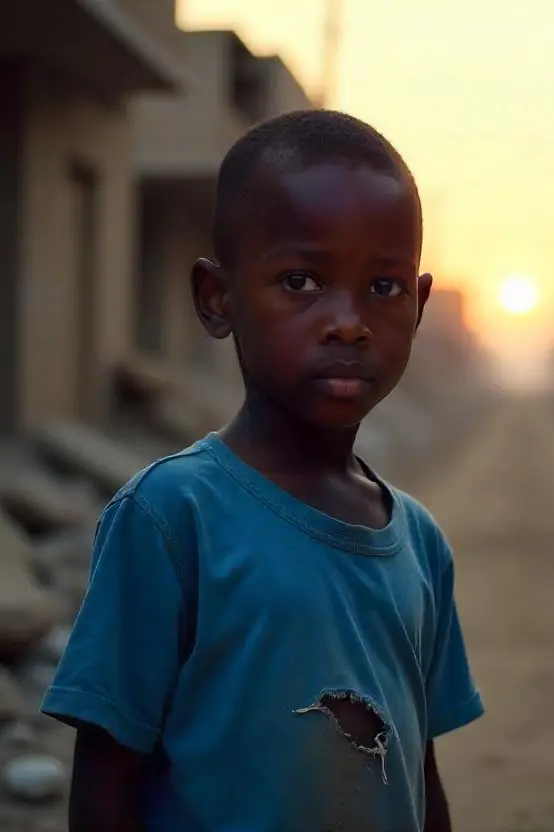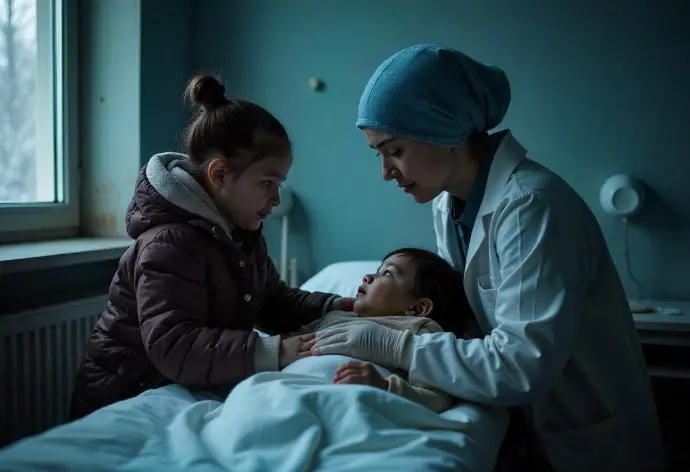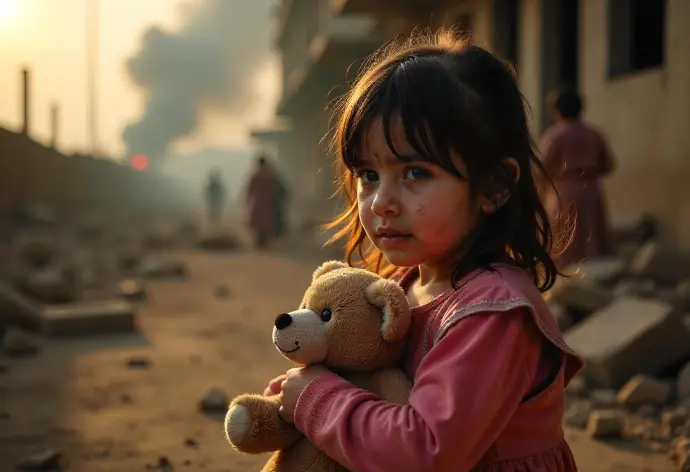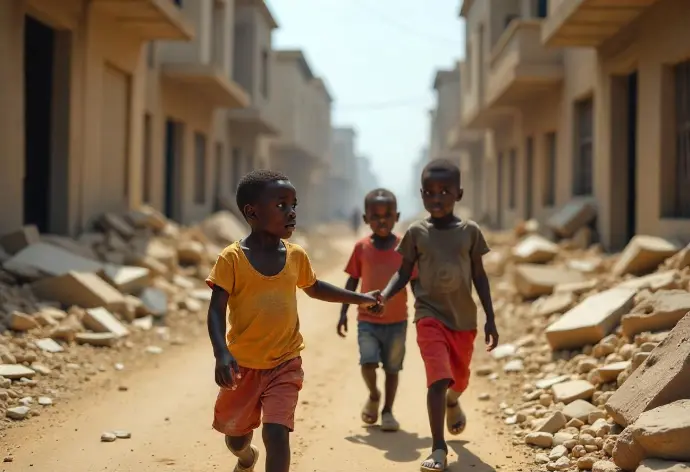
In this space dedicated to the exhaustive exploration and in-depth analysis of global human rights, we delve into the challenges faced by the most vulnerable. In our feature article, "Children of War: Child Rights Violations in Conflict Zones," you will discover the shocking reality of children suffering in contexts of violence.
Join us to understand the importance of protecting children in conflict situations and discover how we can defend their rights. Keep exploring and join the fight for a more just world!

Children of War: Child Rights Violations in Conflict Zones
Introduction
The situation of children in conflict zones is heartbreaking and alarming. These minors are exposed to an environment of violence, extreme poverty, forced recruitment, sexual abuse, forced displacement, and lack of access to education and healthcare. Armed violence and protracted conflict have a devastating impact on the lives of these children, leaving them vulnerable to serious violations of their fundamental rights.
The lack of protection and constant exposure to traumatic situations profoundly affect the physical, emotional, and psychological development of children in conflict zones. Childhood, which should be a period of innocence and learning, is cut short by the violent circumstances surrounding them.
Understanding the complexity of this context is crucial to effectively address child rights violations in conflict zones and working for the protection and well-being of these vulnerable children.
Child rights violations in conflict zones have a devastating short- and long-term impact. These traumatic experiences can leave profound scars on children's lives, affecting their mental health, their ability to relate to others, their cognitive and emotional development, and even their ability to integrate into society once the conflict has ended.
Lack of access to education and adequate healthcare, exposure to violence, and forced recruitment into armed groups are just some of the situations that have a detrimental effect on children. Furthermore, girls face a greater risk of gender-based violence and sexual abuse, further exacerbating the situation.
It is essential to address the long-term impact of these violations by providing psychological support, healthcare services, and social reintegration programs for children affected by armed conflict.
Asia and the Middle East have been the scene of numerous armed conflicts that have had a devastating impact on children. From the war in Syria and Yemen to the conflict in Afghanistan, children in the region have witnessed and suffered serious violations of their fundamental rights.
Forced recruitment by armed groups, attacks on schools and hospitals, the forced displacement of entire communities, and exposure to violence have left a generation of children with indelible scars. Lack of access to education and adequate healthcare further exacerbates the situation, perpetuating a cycle of vulnerability and suffering.
It is crucial to raise awareness of these violations and work together with governments, international organizations, and civil society to protect children's rights in these regions affected by armed conflict.
Child Rights Violations in Conflict Zones
Child rights violations in conflict zones include a wide range of atrocities that disproportionately affect children. This includes the forced recruitment of children as soldiers, kidnapping, sexual violence, forced labor, recruitment as informants, and attacks on schools and hospitals, which severely disrupt access to education and healthcare.
An alarming example of these violations can be seen in Syria, where it is estimated that more than 2.6 million children are out of school due to the conflict, many of whom have been subjected to acts of violence and forced recruitment by armed groups.
In Yemen, the recruitment of children by armed groups and the destruction of educational infrastructure have been documented, limiting access to education and exposing children to a greater risk of recruitment.
According to the United Nations Children's Fund (UNICEF), at least 142 million children worldwide are estimated to be living in conflict zones, the vast majority of whom are in Asia and the Middle East. Of these, more than 24 million are estimated to be in need of urgent humanitarian assistance.
In Iraq, at least 4.2 million children are estimated to be in need of humanitarian assistance, many of whom have witnessed or been victims of violence, forced recruitment, and forced displacement.
In Afghanistan, the UN reported that in 2019, more than 3,000 children were killed or injured as a result of the armed conflict, and more than 1,000 cases of recruitment and use of children by armed groups were documented.
Child rights violations in conflict zones have a devastating impact on the mental and emotional health of affected children. Many of them experience trauma, anxiety, depression, and post-traumatic stress disorder as a result of violence and the loss of loved ones. Furthermore, the disruption of education and the family environment contributes to further psychological stress.
A study conducted by the World Health Organization (WHO) found that 50% of children in Gaza showed symptoms of post-traumatic stress disorder, and that more than 80% suffered from sleep problems as a result of the conflict in the region.
These emotional and psychological impacts have long-term consequences on children's well-being, underscoring the urgency of addressing these child rights violations in conflict zones.
Child rights violations in conflict zones have generated responses at both the international and local levels. At the international level, organizations such as UNICEF, the Red Cross, and Amnesty International have played a critical role in protecting children affected by armed conflict. These organizations have provided humanitarian assistance, psychological support, access to education, and advocated for the implementation of international laws and treaties that protect children in conflict situations.
At the local level, in conflict zones, various non-governmental organizations (NGOs), religious institutions, and community groups have worked hard to provide support to affected children. These local organizations often have deeper knowledge of the situation on the ground and can provide direct assistance to affected communities. In addition, local and national governments have also implemented programs and policies to address the specific needs of children in conflict zones, although the effectiveness of these responses can vary considerably depending on the political and social context.
While there are significant efforts at the international and local levels to address child rights violations in conflict zones, ensuring effective protection for all affected children remains a crucial challenge. Coordination between international and local organizations, sustained support from the international community, and the engagement of conflict actors are critical to mitigating the devastating impact of armed conflict on children.
Factors Contributing to Violations
The impact of armed conflict on children is devastating and has long-term repercussions. Children growing up in conflict zones face unique challenges that affect their physical and mental health, their access to education, and their safety. Constant exposure to violence and a lack of basic resources, such as food and clean water, contribute to an unstable environment that hinders children's healthy development.
Furthermore, the disruption of health services and the destruction of educational infrastructure further limit children's opportunities in conflict-affected areas. Lack of access to adequate healthcare and quality education has a lasting impact on children's lives, perpetuating the cycle of poverty and marginalization.
Violence and armed conflict also generate a climate of fear and anxiety that affects children's emotional well-being. Exposure to traumatic situations, such as armed attacks or the loss of loved ones, leaves psychological scars that require specialized support for recovery.
The forced displacement of entire families as a result of armed conflict is a heartbreaking reality affecting millions of children around the world. Refugee and internally displaced children face extremely difficult conditions, with limited access to food, shelter, and basic services. The lack of stability and uncertainty about their future have a significant impact on their emotional and psychological well-being.
Furthermore, lack of documentation and discrimination in host countries often hinder these children's access to education and healthcare. The vulnerability of refugee and displaced children puts them at greater risk of exploitation, abuse, and forced recruitment by armed groups.
It is critical to address the specific needs of displaced and refugee children, ensuring their protection, access to education and healthcare, and providing them with a safe and supportive environment to overcome the difficulties they face.
The recruitment of children as soldiers and their participation in armed conflict is a flagrant violation of their fundamental rights. In conflict zones, armed groups recruit children, often through the use of force or coercion, to participate in hostilities, exposing them to situations of grave danger and extreme violence.
Furthermore, many children are forced to work in exploitative conditions, performing dangerous and exhausting tasks in conflict environments. The lack of economic opportunities and the disintegration of social support networks make them especially vulnerable to labor exploitation.
Urgent measures are essential to protect children from these abusive practices, providing them with psychosocial support, reintegration into society, and education and training opportunities that will enable them to build a future free from violence and exploitation.
In conflict zones, one of the most serious impacts on children is restricted access to education and healthcare. In many cases, schools are destroyed or used for military purposes, significantly limiting their ability to receive an adequate education. This not only affects children's personal development but also perpetuates a cycle of poverty and lack of opportunities for the future.
Furthermore, lack of access to adequate medical care is one of the most worrying consequences in conflict zones. Children face illness, injury, and psychological trauma without the opportunity to receive necessary treatment. Medical infrastructure is often overwhelmed or inaccessible, exacerbating the situation and putting the lives and well-being of children affected by conflict at risk.
The denial of access to education and medical care constitutes a clear violation of children's fundamental rights, and it is imperative that the international community take action to ensure that all children, regardless of their geographical location or political status, have access to these essential services for their development and well-being.
Challenges in the Protection of Children's Rights
The protection of children's rights in conflict zones faces numerous challenges that hinder its effective implementation. These challenges include limitations in the implementation of international laws and treaties, corruption and lack of resources in conflict-affected areas, as well as cultural and social obstacles to child protection.
In conflict zones, the implementation of international laws and treaties that protect children's rights can be significantly limited. The lack of an effective judicial system, the presence of non-state armed groups, and the absence of adequate oversight mechanisms contribute to impunity in cases of child rights violations. This creates an environment in which those responsible for these violations rarely face legal consequences, thus perpetuating the vulnerability of children in these areas.
Difficulties in ensuring the implementation of international laws and treaties can also be related to the lack of cooperation between actors involved in the conflict, as well as the lack of resources and capacities to conduct investigations and judicial proceedings that guarantee the protection of children's rights.
The international community plays a crucial role in strengthening mechanisms to enforce these laws and treaties, as well as in providing technical and financial support to overcome these limitations and ensure the protection of children in contexts of armed conflict.
Corruption and lack of resources in conflict-affected areas are significant contributors to children's vulnerability. Corruption can weaken government structures charged with protecting children's rights, diverting resources from programs and policies to their own benefit and leaving children most in need unprotected.
Furthermore, the lack of financial resources, adequate infrastructure, and access to basic services such as health and education resulting from protracted conflict exacerbates children's vulnerability. The lack of adequate funding for child protection programs, as well as the destruction of key infrastructure, hampers the ability of governments and organizations to provide the necessary assistance to children affected by conflict.
Fighting corruption and mobilizing resources at the national and international levels are critical to addressing these challenges and ensuring that children affected by conflict receive the protection and support they need.
Cultural and social obstacles also represent a significant challenge in protecting children's rights in conflict zones. Deep-rooted cultural norms, traditional gender roles, and discriminatory practices can limit children's, especially girls', access to education, healthcare, and participation in decision-making that affects their lives.
Furthermore, in some contexts, local traditions and social structures can perpetuate violence against children, including forced recruitment into armed groups, child marriage, and child labor. These cultural and social obstacles require context-sensitive and tailored approaches to ensure that children's rights are respected and protected, even in times of conflict.
Addressing these challenges requires a comprehensive approach that involves local communities, religious and traditional leaders, as well as international organizations and national governments. Awareness-raising, education, and the promotion of norms and practices that protect children's rights are critical to overcoming these obstacles and ensuring a safe and protective environment for children in conflict zones.
Actions and Measures for the Defense of Children's Rights
Children who have been victims of armed conflict face profound psychological trauma that requires specialized care. Rehabilitation and psychological support programs are essential to help these children overcome the emotional aftermath of war. These programs typically include individual and group therapy, recreational activities, and safe spaces where children can express their emotions. They also focus on the early identification of mental disorders and providing the necessary assistance for each individual case.
It is crucial that these programs be implemented by professionals trained in child mental health, who can provide a sensitive approach tailored to the specific needs of children affected by conflict.
As a rough quote, Kofi Annan said: "The mental health of children affected by armed conflict is a priority; we must ensure they receive the necessary support to heal the invisible wounds they have suffered."
In conflict zones, children's access to education and healthcare is often limited or even nonexistent. It is critical to implement interventions that guarantee access to education and healthcare for these children, as this not only provides them with opportunities for holistic development but also provides them with a safe and structured environment that counteracts the negative effects of conflict.
These interventions may include the creation of temporary schools, the provision of educational materials, the training of teachers skilled in working in crisis settings, and the launch of mobile clinics that provide basic medical care to affected communities.
As an essential part of defending children's rights in conflict zones, these interventions seek to provide affected children with the necessary tools to build a more hopeful future.
Children in conflict zones are especially vulnerable to exploitation, forced recruitment, abuse, and other forms of violence. Legal protection and advocacy for the rights of children affected by conflict are critical aspects of ensuring their well-being and safety.
This involves implementing measures to prevent the recruitment of children by armed groups, creating early warning systems to identify and protect children at risk, and collaborating with local authorities and international organizations to ensure that children's rights are respected in accordance with international law.
As part of these actions, it is essential to provide legal counsel and representation to children who have been victims of rights violations, ensuring they receive the protection and support necessary to rebuild their lives.
Children's empowerment and participation in conflict resolution in conflict zones are fundamental aspects of promoting respect for children's rights. When children are involved in decision-making and given the opportunity to express their opinions, their self-esteem is strengthened and their development as active and responsible citizens is fostered. Empowerment allows children to take a more active role in society, which in turn contributes to building more inclusive and peaceful communities.
Involving children in conflict resolution not only provides them with the opportunity to express their concerns and needs but also enables them to contribute creative and constructive solutions. Through educational programs and safe spaces for dialogue, children can learn conflict resolution skills and promote tolerance and mutual understanding. By involving children in peacebuilding, a valuable precedent for respect for human rights is set and the foundation is laid for a brighter future in conflict-affected areas.
Children's empowerment and participation in conflict resolution also contribute to their protection and well-being. By being informed about their rights and empowered to advocate for themselves, children become less vulnerable to exploitation and recruitment by armed groups. Furthermore, by being active participants in the search for peaceful solutions, children can play a crucial role in preventing future conflicts and building more just and equitable societies.
Conclusions
Child rights violations in conflict zones not only affect children immediately but also have a long-term impact on society and future generations. Children who have been victims of violence or recruited as soldiers can experience severe psychological trauma that lasts throughout their lives. This trauma can manifest as post-traumatic stress, depression, anxiety, and other mental disorders.
Furthermore, lack of access to education and exposure to violence can have devastating consequences on children's cognitive and emotional development, which in turn affects their ability to contribute positively to society in the future. It is critical to understand that the impact of these violations transcends the current generation and can be perpetuated in future generations if not effectively addressed.
Therefore, it is imperative to implement psychological and social support programs for affected children, as well as promote initiatives that guarantee their access to education and development opportunities. Only through a comprehensive approach that addresses the long-term needs of these children can the negative impact on society and future generations be mitigated.
Despite efforts by international organizations and governments to protect children's rights in conflict zones, significant challenges remain. Lack of humanitarian access, impunity for perpetrators, misinformation, and the complexity of armed conflicts are just some of the obstacles that hinder the effective protection of children in these situations.
In the face of these challenges, a call for global action involving governments, non-governmental organizations, UN agencies, community leaders, and civil society as a whole is essential. This call must emphasize the need to implement concrete measures to prevent child rights violations in conflict zones, as well as to ensure accountability for those who perpetrate these atrocious acts.
Furthermore, it is crucial to promote investment in post-conflict reconstruction programs that prioritize the protection and well-being of children, as well as the strengthening of justice and child protection systems at the national and international levels. Only through a collective and coordinated effort on a global scale will it be possible to effectively protect children in conflict situations and provide them with the opportunity for a safe and dignified future.

 IHRO NEWS
IHRO NEWS

